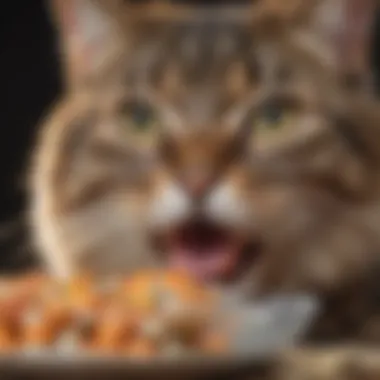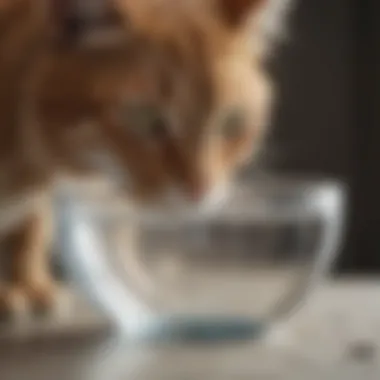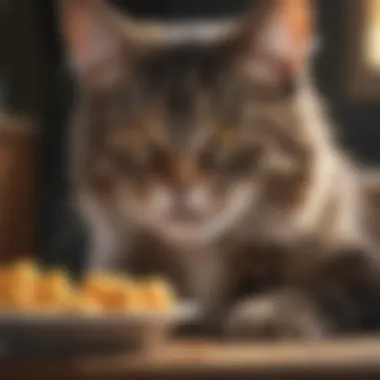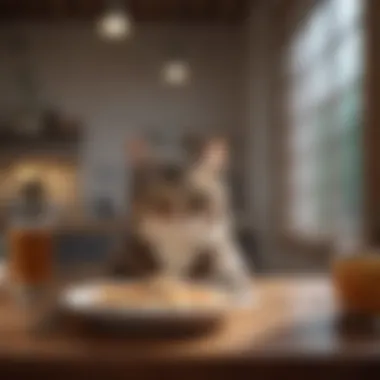Essential Dietary Guide for Cats with Stomatitis


Intro
Feline stomatitis is an ailment that can complicate the life of your cat. Stomatitis is an inflammation of the mouth that causes significant discomfort, leading to difficulties in eating and drinking. This article aims to address management of this issue through dietary strategies. By understanding the unique nutritional needs of cats with stomatitis, owners can improve their pets’ quality of life.
Pet Care Essentials
Caring for a cat with stomatitis requires thoughtful consideration of their dietary requirements and overall wellness. Nutrition is at the heart of maintaining health and comfort.
Daily Nutrition Requirements
Cats with stomatitis may struggle to consume food without pain. Soft, palatable options are crucial in their diet. Consider feeding them:
- Wet food: Canned brands like Hill's Science Diet offer softer textures, often more appealing than dry kibble.
- Moisture: Bouillon or added water can make foods easier to eat while supporting hydration.
- High-calorie supplements: Products like Nutri-Cal can help ensure adequate calorie intake without excessive chewing.
Tailoring their diet to meet essential wellness while being mindful of potential triggers is paramount. Avoid foods with high acidity or abrasive textures.
Exercise and Playtime
Physical fitness is vital for overall resilience and mood. However, it should be balanced carefully; overly vigorous play might cause discomfort. Short, gentle interactive sessions can be beneficial. Simple toys that do not require pushing or tearing can keep them engaged.
Grooming Tips
Regular grooming helps with comfort as well, particularly during an ailment such as stomatitis. Gently brushing their coats can reduce shedding and help create a bond. Be cautious around sensitive areas, focusing on calm interactions.
Health and Wellness Check-ins
Routine health evaluations are beneficial, especially when dealing with stomatitis. Regular consultations with a veterinarian ensure adaptive feeding choices are meeting their needs. This helps track, any potential worsening of the condition, requiring further intervention.
Dietary Adjustments Based on Symptoms
When managing stomatitis, being observant of symptoms is essential. These can guide decisions on what your pet should or shouldn't be eating. If you notice hesitance in eating or unusual lethargy, these can be indications that nutritional adjustments are necessary.
Vet Recommendations on Suitable Foods
Consulting a veterinarian is always a prudent move when it comes to dietary choices for your cat. Experts generally recommend:
- Prescription diets specifically formulatd for oral health
- Foods low in carbohydrates, which can exacerbate inflammation
- Protein sources without known allergens
Holistic Approaches to Consider
Some pet owners explore other areas. Herbal remedies or homeopathic treatments might provide alongside traditional medical treatment. Always consult a vet prior to any change.
Remember: Diet impacts the overall process of healing in cats with stomatitis. Giving as much soft, nutritious food can Couch your cat through challenges, emphasizing comfort and nutrition.
Understanding Stomatitis in Cats
Stomatitis is a complex issue affecting many cats. It requires attention from pet owners, not just for treatment but also for understanding its impact on the animal's daily life. Recognizing these challenges can help owners provide proper care for their cats, enhancing their quality of life immensely.
Definition and Symptoms
Stomatitis is defined as the inflammation of the oral cavity and surrounding structures. It can manifest as painful lesions, redness, and swelling. Cats with stomatitis may present various symptoms, including:
- Difficulty in eating or chewing food.
- Excessive salivation or drooling.
- Bad breath (halitosis).
- Changes in behavior such as irritability or a desire for solitude.
Owners may also notice a reluctance to groom themselves or play due to discomfort caused by the oral condition. With awareness, one can notice these signs earlier, fostering timely intervention.
Potential Causes
The exact causes of stomatitis remain largely unclear; however, several factors may contribute to its development, including:


- Dental Disease: Plaque buildup and periodontal disease can trigger inflammation in some cats.
- Immune System Response: Some cats may have an overactive immune response that results in inflammation in the mouth.
- Viral Infections: Feline herpesvirus and calicivirus are common in cats, and might play a role in stomatitis.
- Underlying Conditions: Diseases like feline immunodeficiency virus (FIV) can complicate or exacerbate the condition.
Understanding these factors may assist owners in taking preventative measures while seeking appropriate treatment options.
Diagnosis and Treatment Options
Diagnosing stomatitis usually requires a veterinarian's examination. The vet will check for inflamed tissues and may recommend several tests to rule out other conditions. Once diagnosed, treatment options vary based on severity and can include:
- Professional Dental Cleaning: Removing plaque and tartar buildup is crucial.
- Medications: Anti-inflammatory drugs or antibiotics might be prescribed.
- Dietary Changes: Changes to the diet can help soothe inflammation and allow easier eating. Soft foods are crucial.
- Dental Surgery: In severe cases, tooth extraction may be necessary.
Asking about options and ensuring close monitoring of your pet’s condition is essential to managing stomatitis and ensuring a better quality of life for the cat.
Nutritional Needs of Cats with Stomatitis
Feeding a cat with stomatitis requires a specialized approach. The right nutritional choices play a crucial role in managing this condition. The primary objective is to reduce discomfort, promote healing, and ensure the cat receives the essential nutrients vital for overall health. Owners must steer clear of typical feeding routines because stomatitis affects a cat's ability to eat comfortably.
Importance of a Balanced Diet
A balanced diet is essential for cats suffering from stomatitis. Various components, such as proteins, fats, and carbohydrates, need to be present in the food. High-quality protein helps in rebuilding tissue in the mouth, while carbohydrates give energy. However, it is important not to introduce allergenic ingredients, as some cats might react negatively.
Including omega-3 fatty acids can aid in reducing inflammation, and antioxidants help support the immune system.
- Quality ingredients are key. Focus on foods that list protein sources as the first few ingredients.
- Avoid fillers like corn and soy, which offer little nutritional value and might aggravate gastrointestinal discomfort.
An optimal diet not only aids recovery but can also contribute to the cat's long-term health by preventing future complications.
Role of Moisture in Cat Food
Moisture content in cat food is particularly important for stomatitis. Cats often prefer moister foods when interacting with painful sores in their mouths. Wet food is advantageous because it can help:
- Keep the cat hydrated, which is critical for oral health.
- Soften the food, making it easier to chew and swallow.
- Enhance actual food intake, as dry kibble might be too painful to consume.
Several brands offer high-moisture options that cater to these unique dietary needs. Consider introducing more canned or pouch food into their diet.
Essential Vitamins and Minerals
Vitamins and minerals are invaluable components for any cat's diet, especially those with stomatitis. Critical nutrients include:
- Vitamin A - Supports skin and tissue repair.
- Vitamin E - Acts as an antioxidant and contributes to overall health.
- B-vitamins - Important for energy metabolism and promoting healing processes.
- Calcium and Phosphorus - Essential for teeth and bone health.
- Zinc - Plays a role in the healing of oral tissues.
Incorporating these components into a cat's diet can have a positive impact on the management of stomatitis. A visit to the veterinarian can help determine if additional supplementations are necessary.
A well-thought-out diet can enhance dental health and minimize discomfort associated with stomatitis, leading to better quality of life for your cat.
Recommended Food Types
Selecting the right food types for cats suffering from stomatitis is crucial for their recovery and comfort. Proper nutrition not only eases the discomfort associated with inflammation but also helps in the overall healing process. The food type plays a significant role in ensuring that a feline can maintain a balanced diet without causing further irritation or pain. Understanding the nuances between soft and wet foods, prescription diets, and homemade options offers pet owners valuable insight in making appropriate choices for their cats.
Soft and Wet Foods
Soft and wet foods are highly beneficial for cats affected by stomatitis. These foods reduce the risk of aggravating tender gums and sensitive mouth tissues. Their soft texture eliminates the need for rigorous chewing, allowing cats to eat without worsening their inflammation.
Moreover, these foods, which come in various flavors and formulations, usually offer higher moisture content. Increased moisture helps support hydration, which is key given the potential for decreased food and water intake in these cats. Additionally, soft food may come fortified with essential nutrients that are necessary for recovery.
When choosing soft or wet food, areas to consider include:
- Quality: Opt for established brands with clear ingredient labels.
- Palatability: Find flavors that appeal to the cat’s preferences.
- Nutritional Value: Select products that offer complete and balanced nourishment.
Prescription Diets


Prescription diets are tailored specifically for pets with health issues, including stomatitis. Veterinarians often recommend these diets to manage specific symptoms or nutritional needs. These diets are formulated to be gentle on the digestive system, while also providing essential nutrients to combat inflammation.
Using prescription diets can decrease the instances of painful flare-ups. Ingredients are carefully selected to enhance healing while keeping an optimal balance in nutrition and energy levels. Common features include allergen-free options and heightened bioavailability of nutrients. Veterinary professionals play a key role in guiding pet owners in selecting suitable prescription diets for their cats.
Homemade Diets
Homemade diets provide an alternative for pet owners looking to control every ingredient their cat consumes. When planning a homemade diet, however, it is vital to understand proper nutrition to avoid deficiencies.
Ingredients to Include
When preparing a homemade diet for a cat with stomatitis, including well-cooked rice, chicken, or fish can be quite valuable. These options are readily digestible and help ease the dietary transition. To focus on soothing the inflamed mouth, try these ingredients:
- Soft vegetables like cooked carrots or zucchini.
- High-quality protein sources like boiled chicken or turkey.
- Omega-3 fatty acids from fish to support anti-inflammatory effects.
These ingredients allow you to customize meals according to your cat's taste and specific health needs. An important characteristic is their ability to be quickly digested, thus encouraging a healthier appetite during periods of discomfort.
Ingredients to Avoid
In crafting a homemade diet, knowing which ingredients to avoid is equally critical. Access to proper nutrients shouldn’t come with potential risks. Being cautious helps maximize comfort and benefits for a cat suffering from stomatitis.
Ingredients that should generally be excluded include:
- Hard kibble that requires intense chewing, irritating sore mouths.
- Acidic foods like tomatoes or citrus, which may aggravate inflammation.
- Artificial preservatives or fillers that have no nutritional value.
Understanding these criteria ensures that homemade diets can be effective. By focusing on healthy choices, cat owners contribute to a more convalescent-friendly feeding experience.
It is important to consult a veterinarian for specific, tailored recommendations when adjusting your pet's diet. An expert opinion significantly enhances the chance of achieving optimal health results.
Monitoring Food Intake
When managing a cat with stomatitis, understanding their eating habits becomes crucial. Monitoring food intake is not just about making sure the cat eats enough; it involves observing how they eat, their preferences, and any changes in their behavior around food. Such observation helps in identifying patterns which may indicate discomfort or changes in health. By paying attention to various elements of your cat's eating habits, you can make informed decisions that promote better health and comfort.
Recognizing Changes in Appetite
A sudden change in appetite can be one of the first signs that a cat is experiencing discomfort due to stomatitis. This condition can lead to significant pain, making eating difficult. Cats may begin to eat less, refuse their usual food, or only eat soft, wet food. Being vigilant about these changes is important.
Observed changes may include:
- A noticeable decrease in how much your cat eats
- Preferring softer food textures
- Showing reluctance to chew or more finicky eating habits
- Eating and drinking more slowly than usual
If you see these signs persistently, it can be an indicator that the currently provided diet is not suitable for the condition.
Tracking Preferences and Aversions
Taking note of food preferences and aversions helps customize the diet for a cat afflicted with stomatitis. Cats often prefer certain flavors or textures, which may vary greatly. Cats may gravitate towards moist, flavorful food like canned chicken or fish, while turning away from dryer options. Documenting these likes and dislikes is useful for understanding how to best help your cat feel comfortable during mealtime.
When tracking these patterns, consider:
- Keeping a food diary to note what was eaten, in what quantity, and how fast your cat consumed it
- Observing any meals that lead to visible pain or hesitation in eating
- Trying various food types to discover their favorites, as palatability can change and vary from one meal to another
For example, if you notice your cat swiftly consumes tuna, but remains uninterested in chicken kangaroo, that could guide future meal selections.
Adjusting Portions Appropriately
Portion control may become necessary based on a cat’s appetite and comfort level while eating. Adjusting serving sizes can help encourage regular eating without overwhelming the cat. Too large of a portion can lead to stress and disinterest in food.
Consider these factors when adjusting portions:
- If your cat is not eating much, serve smaller portions more frequently throughout the day
- Focus on stimulating appetite with more flavors and optimal texture, rather than aiming for higher quantity
- Monitor your cat’s weight during this process, ensuring they stay in a healthy range


Overall, evaluating the food intake journey your cat experiences arms you with valuable information. This allows for enhanced meal planning, consultation with your veterinarian, and consistent adjustments for the best feeding strategy to mitigate pain from stomatitis and aid in recovery.
Hydration Considerations
The role of hydration is crucial for overall health, especially for cats with stomatitis. Stomatitis can lead to discomfort in the mouth, making the act of drinking painful or difficult. This condition may result in a decreased fluid intake, which can exacerbate existing health issues like kidney disease or urinary tract infections. Being attentive to a cat’s hydration needs assists in their recovery and comfort during a difficult period.
Importance of Water Intake
Water intake is essential in supporting a cat’s physical health functions. Here are a few key points about the significance of water for your feline:
- Aids Digestion: Water aids in the digestive process and helps ease the passing of food through the gastrointestinal tract.
- Prevents Dehydration: Dehydration can lead to more serious health issues, particularly in cats, so you must monitor fluid intake.
- Flushes Toxins: Adequate hydration helps combined kidney function, alleviating excretory responsibilities.
- Regulates Body Temperature: Water is vital for maintaining an optimal body temperature and keeping organs function properly.
While some cats might consume sufficient water from wet foods, others need a conscious effort from their caretakers to ensure they stay hydrated.
Encouraging Hydration
Encouraging proper water intake is a proactive step for managing a cat’s comfort and health. There are several strategies to promote hydration in felines suffering from stomatitis:
- Fresh Water: Always provide fresh water in different bowls. Cats might prefer drinking from certain locations.
- Water Fountains: Some cats prefer running water. Fluid intake can increase if powered fountains are provided.
- Wet Food: Incorporonce wet or canned foods into their diet boosts hydration. It is softer on their mouths and contributes additional liquid content.
- Flavored Water: Trying low-sodium broths may entice a cat to drink more. Such options can mask the taste of plain water.
- Pate Consistency: When choosing the wet food, opt for pates as they're easier to manage.
Generally, fostering an environment where drinking water is an accessible and pleasant activity results in better health outcomes for your cat.
Veterinary Consultation
Having a thorough veterinary consultation is essential when managing dietary needs for cats with stomatitis. This condition can be complex, affecting a cat's overall health and well-being. A qualified veterinarian can dissect the specifics related to your cat's symptoms while considering other underlying health issues. This personalized approach not only aids in discerning which dietary modifications are crucial but also ensures the cat receives adequate nutrition during recovery.
When to Seek Professional Advice
Timely intervention is crucial. You should contact a veterinarian if:
- Your cat shows persistent signs of discomfort while eating,
- There’s noticeable inflammation or bleeding in the mouth,
- Changes in eating habits or significant weight loss occur,
- Slower recovery from common illnesses,
- Any sudden increase or decrease in thirst.
By visiting a veterinarian, pet owners can make the right moves sooner rather than later. This step could alleviate the further progression of stomatitis, leading to enhanced quality of life for the cat.
Communication with Your Veterinarian
Effective communication with your veterinarian plays a substantial role in your cat's treatment. When discussing your cat's stomatitis, make sure to include:
- Symptom History: Document any changes in eating and drinking patterns.
- Current Diet: Provide a full list of the food and treats you've been giving.
- Allergies or Sensitivities: Mention any known food allergies or sensitivities.
- Behavioral Changes: Take note of any behavioral shifts like increased aggression or withdrawal.
(() QA3Z7bDO) Understanding the pinpoint of stomatitis allows the veterinarian to tailor recommendations and properly assess the need for specialized diets, supplements, or medications.
By prioritizing these steps, you foster a robust partnership with your vet, enhancing your cat's healing process and making informed choices about their dietary management.
Preventive Care and Management
Preventive care and management are integral to reducing the frequency of stomatitis episodes in cats, alleviating pain, and enhancing overall quality of life. Recognizing the role of preventive strategies is vital for cat caregivers seeking a proactive approach toward their pet’s oral health. Effective management begins with understanding that regular dental care directly influences holistic wellness. Taking measures can avoid complications from poor dental management, which often leads to escalating health issues, in addition to stomatitis.
Regular Dental Check-Ups
Routine veterinary assessments play a critical function in preventing stomatitis in cats. Time spent in a veterinary dental check-up could reveal underlying problems before they escalate. More than just clean teeth, these appointments help in assessing oral health, providing an opportunity for professionals to identify swollen gums, plaque buildup, or prior evidence of stomatitis.
While examining teeth and gums, vets usually recommend:
- Frequent cleanings: Professional dental cleanings minimize the risks of tartar accumation, thus preventing periodontal disease.
- Oral health products: Specific dental treatments or toothpaste made for cats can be suggested based on their unique condition.
- Early detection: The earlier an issue is discovered, the easier and more effective the treatment tends to be.
Taking your cat for regular visits enables the dental professional to tailor a prevention plan, addressing unique needs influenced by age or preexisting health conditions.
Monitoring for Recurrences
Keeping an eye on your cat’s recovery journey after stomatitis treatment is as essential as initial nutritional choices. Monitoring for recurrences involves being alert to signs that may indicate a return of the condition. Signs include difficulty eating, drooling, or any visible oral inflammation. These symptoms warrant immediate veterinary consultancy. Ensuring a home routine that focuses on hydration and proper food can assist in reducing the risk of any regressive behavior.
A checklist may help monitor feline health:
- Check for gum issues: Periodically inspect your cat’s gums for redness or swelling.
- Track eating habits: Note inconsistencies in feeding or additional distress during meals.
- Ensure regular vet visits: Consistent veterinary check-ups promote ongoing assessment and support preventative action.
Effective management entails both cautious observation and educated decisions to navigate potential issues that can arise from stomatitis. Failure to manage this condition adequately can disrupt a cat's health and happiness.







